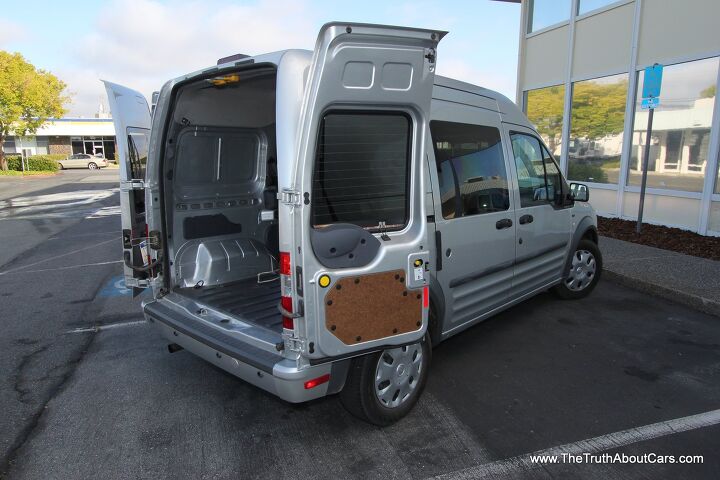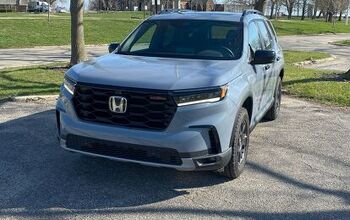Commercial Week Day Four Review: 2012 Ford Transit Connect

Americans with well worn passports often amaze their less-traveled friends with miraculous tales of a land full of tiny, fuel-efficient vehicles, expensive gasoline and miniature cans of Coke. (Really, those Coke cans are awesome.) The story inevitably ends with, “I wish I could buy X here”. Ford has so far been the most receptive to these cries, with the tasty Euro Focus, Fiesta (and soon the Fusion/Mondeo) to our shores. But what about some fuel-efficient love for the man-in-the-van? That’s where the Transit Connect fits in according to Ford. TTAC is no stranger to the Transit Connect with our own Sajeev Meta taking a spin in 2009. However in this review, we’ll attempt to compare the Connect to the other commercial options on the market while channeling our inner Joe-six-pack.
The Connect is off to a good start, with sales climbing from 8,834 in 2009 to 31,914 in 2011 proving there is a market for a mini-bread-van. The small hauler even accounted for 21.4% of Ford’s US van sales in 2011. Meanwhile, sales of the ancient and thirsty E-Series increased from 85,735 units to 116,874 from 2010 to 2011. By comparison, GM shifted just 89,211 vans in 2011. The reason behind the sales jump is obvious: high gas prices and no efficient cargo haulers to compete with it. But does that mean you should own one?
The overall look is awkward to the American eye with a tall box grafted onto a long car-like hood, but looks aren’t what this vehicle is about. Compared with the E-150, the full-sized van is 36 inches longer, 9 inches wider but only 3 inches taller on the outside. The inside is where things get interesting. The E-150 supports a cargo hold 120 x 73 x 52 (L x W x H in inches) while Connect provides 81 x 59 x 59, that’s actually 7-inches taller than the E-150. Getting bulky cargo inside the Connect is easy with a cargo hold opening that is 51.1 x 52.1 inches (W x H) compared to the E-Series 53.9 x 49.5. More importantly, the load floor that is 5.5 inches lower and the double doors open a full 255-degrees magnetically latching to the side of the van. If you prefer to talk in cubes, the Connect will haul 107 fewer cubic feet of widgets (130) than the E-150. Sounding too good to be true? The light 1,600lb maximum payload (half what a base E-150 will haul) limits the Connect to lighter hauling than even a Chrysler minivan (1,800lbs) and should be kept in mind before you buy one for your metal recycling business.
Compared to the RAM C/V, the Transit Connect is 22-inches shorter, 8-inches narrower but 10.4 inches taller. While Chrysler was unable to provide us with a RAM C/V to test, there are a few problems with the blue-collar Caravan you should know about. The C/V retains the Caravan’s tailgate making access more difficult when being loaded by a forklift or tall employee. In addition, despite being nearly two feet longer than the Ford, the RAM’s cargo hold is only 17 inches deeper, and although it is 3 inches wider, it’s nearly a foot shorter. The RAM’s ability to carry 4×8 sheets of whatever is appealing, but the cargo opening is smaller at 45×40 inches vs the Connect’s 50×52 inch opening. Who cares? Pallet fans. All standard North American pallet sizes fit in the Connect while only the smallest of the sizes will fit in the RAM. Where does that leave us on cargo? The Connect’s light payload precludes the baby-Ford from being used in heavy-hauling activities like carpet cleaning where a cleaning unit and waste tank can easily reach 1,900lbs. However, general cargo hauling, palletitzed items, bakeries, dry-cleaners, pet businesses, cleaning services and electricians may find the fuel economy and maneuverability outweigh the payload capacity.
The cabin of the Transit Connect is turn-of-the-century Euro-Ford. From the air vents to the steering wheel and center-mount window switches it’s obvious this Turkish delight hails from the old world. Despite the Connect’s European origins, the seats are broad enough to accommodate even the most American-sized drivers, but the padding could be thicker for long journeys. Due to the proportions, taller drivers downsizing from the E-Series will be surprised by more headroom (an epic 51 inches), an inch more legroom and a footwell that’s considerably wider and taller than the full-sized van (due to the engine being entirely under the hood half way into the cabin). If you have size 12 or larger feet, the difference is tremendous with the E-150 constantly making me feel as if I was trapped.
For 2012, Ford killed the awful Work Solutions in-dash computer (as pictured above) and replaced it with the optional ($395) SYNC system which is a considerable improvement over the former Euro headunit in terms of iPod and USB connectivity as well as sound quality. On the downside it means that a navigation system is no longer offered. Should you need to GPS track your fleet, Ford offers their Crew Chief solution from the factory for $925. Aiding inner-city parking are optional parking sensors and a backup cam, available together for $470. For some reason Ford chose not to re-key the Connect for the American market retaining the unusual Tibbe key which is more common across the pond but on these shores are almost exclusively found on pre-2006 Jaguars. The Euro-novelty key can cost up to $200 if you lose it. Ouch.
Shuttling the baby-bread-van around is Ford’s ubiquitous 2.0L four-cylinder engine and four-speed automatic borrowed from the previous generation American Focus. With just 136HP at 7,000RPM and 128lb-ft at 4,750RPM on tap, the Connect is far from swift, but considering it weighs 1,900lbs less than the E-150, it’s just as quick as the 235HP full-sized Ford. The missed opportunity with the Connect is obviously the ancient four-speed automatic which seems to hunt for gears frequently when hill climbing and rarely finds what it’s after. Should you feel gaseous, the Connect is available with factory Compressed Natural Gas (CNG) prep for $315 which consists largely of hardened valve seats. To complete the CNG picture, you take your Transit to a conversion company and they remove the gas tank and install the gas cylinders. While there is usually a net loss in cargo space as a result of the conversion, California and a few other states will allow certified conversions to drive solo in HOV lanes which may offset the reduction in capacity for some.
In order to test the Transit Connect properly, I grabbed some friends, loaded it to the gills and went camping. This was possible because our tester was a 5-seat “wagon”, the result of an import tax dodge. Not wanting to bore readers with the details, all Connects are built in Turkey with seats and rear windows and cargo-style floor covering. When they get to Baltimore, those destined for cargo duty have the seats removed and windows replaced with steel inserts. If you want a 5-passenger van, Ford will just skip all the needless destruction. Back to the camping: with three 200lb adults and some 1,000lbs total of camping gear, a generator, 60 gallons of water and 1/8 cord of firewood, the Connect was riding low on the dirt roads of the “lost coast.” Thankfully the combination of FWD and high ground clearance (7.9 inches vs 5.6 on RAM C/V) and fairly short wheelbase (114 inches) made easy work of the rutted terrain and proved the Connect would perform admirably on the imperfect surfaces of the average construction site. Out on the open road, the Connect doesn’t feel “car-like” despite its car-origins, this is thanks to the solid rear axle and other “heavy duty” suspension tweaks. While feeling more like a little truck than a minivan, the Connect is surprisingly nimble in the city with a 39′ turning radius. That may sound large to some of us, but in the world of commercial vehicles this is positively tiny, cutting a circle 8 feet smaller than the E-Series, 4 feet smaller than GM’s V6 van, 9 feet smaller than GM’s V8 van and a whopping 14-feet smaller than GM’s extended wheelbase wares.
Over 1,100 miles I helped my brother move, commuted in traffic, and spent 4 days driving and camping from San Jose to Eureka. Despite the hauling, commute traffic and sustained 76MPH highway speeds on our road trip (and the resulting 3,100RPMS thanks to ye olde 4-speed automatic), the Connect never dropped below 20 MPG, a significant improvement over the V8 E-Series on essentially the same journey. That 20MPG number is the reason that Jane-six-pack buys the Transit Connect for her trendy cupcake delivery service and it’s also the reason Joe-six-pack should seriously consider whether the space and hauling capacity of the E-Series is required. If not, the Connect makes a compelling case against the full-size work vehicles. Until Fiat/Chrysler bring over the Doblo vans as promised and Nissan brings the baby-NV to market for the commercial segment, the Transit Connect is your best choice for reducing the footprint of your fleet. Or is it? Visit TTAC tomorrow to find out.
This is part four of a five-part series on commercial vehicles. Click the links below for the others in this series:
2012 Chevrolet Express / GMC Savana
Ford provided the vehicle, insurance and one tank of gas for this review.
Specifications as tested
0-60: 11.8 Seconds
Average fuel economy: 20.5MPG over 1,105 miles

More by Alex L. Dykes
Latest Car Reviews
Read moreLatest Product Reviews
Read moreRecent Comments
- Brian Uchida Laguna Seca, corkscrew, (drying track off in rental car prior to Superbike test session), at speed - turn 9 big Willow Springs racing a motorcycle,- at greater speed (but riding shotgun) - The Carrousel at Sears Point in a 1981 PA9 Osella 2 litre FIA racer with Eddie Lawson at the wheel! (apologies for not being brief!)
- Mister It wasn't helped any by the horrible fuel economy for what it was... something like 22mpg city, iirc.
- Lorenzo I shop for all-season tires that have good wet and dry pavement grip and use them year-round. Nothing works on black ice, and I stopped driving in snow long ago - I'll wait until the streets and highways are plowed, when all-seasons are good enough. After all, I don't live in Canada or deep in the snow zone.
- FormerFF I’m in Atlanta. The summers go on in April and come off in October. I have a Cayman that stays on summer tires year round and gets driven on winter days when the temperature gets above 45 F and it’s dry, which is usually at least once a week.
- Kwik_Shift_Pro4X I've never driven anything that would justify having summer tires.




















































Comments
Join the conversation
This would be an ideal florist delivery van . The tall roofline would accomodate the tallest flower arrangements , the relatively small size makes it much better than its bigger brothers for urban parking and the better city/suburban gas mileage is more important for a business where driving is in more congested areas.Also , with the engine in front the floor wouldn't be a ridiculous feet-roasting , flower killing oven like an Econoline or Express . Wish it came with a diesel and/or a stick though .
I've never understood how a utility trailer trumps a pick up truck/van. I guess if you have an overabundance of space to park things, and you don't need to worry about yearly registration or insurance for it. If I didn't need to occasionally haul motorcycles I wouldn't have anything remotely truck like.